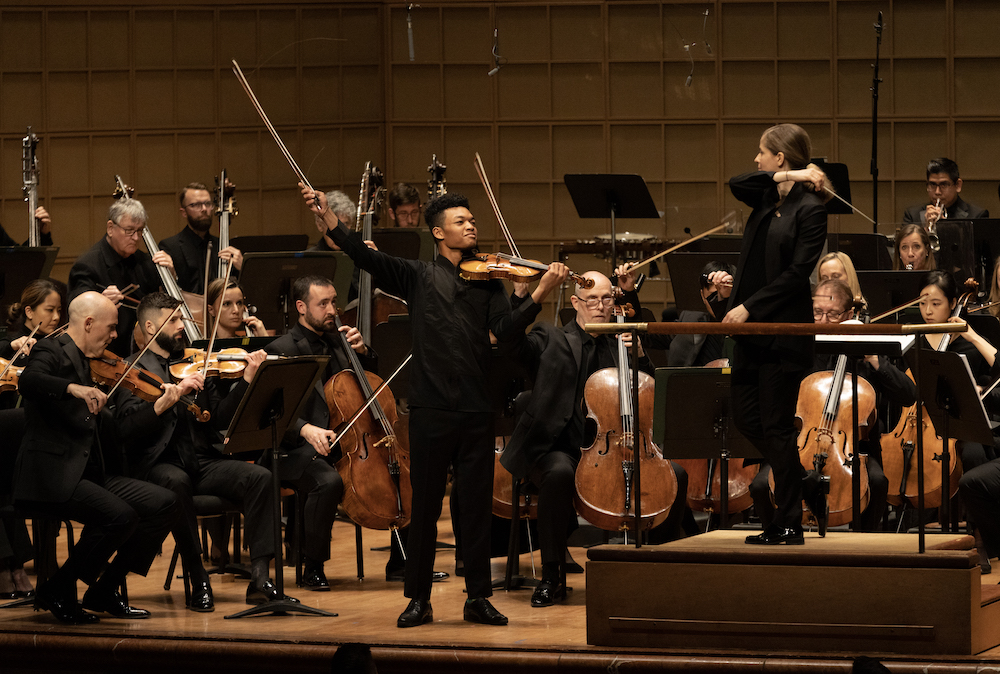Canellakis excels in return to Dallas podium; violinist Goosby shows promise

The Dallas Symphony this weekend features a familiar favorite guest conductor, Karina Canellakis, as well as the DSO debut of a young violinist, Randall Goosby. Canellakis was DSO assistant conductor from 2014 to 2016, and her reputation has only grown alongside a resume of groundbreaking firsts for a woman conductor: the Nobel Prize concert in 2018; first night of the BBC Proms in 2019; principal guest conductor of the London Philharmonic in 2020.
While the bio in the DSO program includes some of these accomplishments, curiously it omits her Dallas experience. Be that as it may, Canellakis’s reception in Dallas on Friday night at Meyerson Symphony Center was overwhelmingly positive. The orchestra began with Dvořák’s seldom-heard The Wood Dove, one of five tone poems based on dark folk tales that he composed late in life. Here, a woman poisons her husband and remarries a younger man but, haunted by a dove who first appears on her murdered spouse’s grave, she eventually drowns herself.
Friday’s was an excellent performance, with careful attention to the many moods of the piece. Canellakis provided the orchestra with clean downbeats, offering precise, unshowy gestures. However, the orchestra yet again has second violins facing first violins this week, and basses behind the firsts. This setup continues to offer ensemble problems, with the last stands of seconds and, sometimes, the basses falling behind. Choosing any single configuration will create more reliable performances, but firsts facing seconds is working least well.
Following the Dvořák, violinist Randall Goosby performed the Tchaikovsky Violin Concerto with the orchestra. Goosby, the son of a Korean mother and a black American father, is a Decca artist and was a student of Itzhak Perlman. He is particularly interested in performing the works of black composers, as evidenced by his first album, Roots. But as seen this weekend, he doesn’t shy from the big warhorses of the repertoire, either.
Goosby has a charismatic stage presence and a gorgeous but not huge sound. He is still developing clean technique, though, as evidenced by too many missed shifts and dropped notes. He will be interesting to hear again in another three to five years, once he has lots more experience and, hopefully, more precision. As his encore, Goosby played music of one of the composers he champions: Coleridge-Taylor Perkinson’s cakewalk Louisiana Blues Strut. The audience seemed undeterred by any flaws in his performance, giving him one of the most enthusiastic ovations in recent memory.
Similarly, while the program-ending Lutosławski Concerto for Orchestra might not ordinarily be thought of as a crowd-pleasing favorite, Friday’s performance seemed to enthrall listeners, and with good reason. This formidably difficult piece, featuring lots of divisi passages in strings, requires intense focus and clarity for a successful performance. The aforementioned ensemble issues didn’t entirely disappear here, but were balanced out by some astonishingly clean first-movement playing in the first violins and surprisingly good soli playing in the basses to begin the third movement, despite their being relegated to the back left corner of the stage. Overall, this was a top-notch performance under Canellakis’ capable baton.
On a down note, the Dallas Symphony is attempting to replace paper programs with electronic programs accessed with a mobile phone QR code. In the process, they’re alienating a substantial number of their subscribers.
Paper programs are increasingly difficult to find before performances, and QR code signs are multiplying. This change will certainly save money and paper, but it is a bad idea, and not just because it’s already generating complaints. Concertgoers don’t want to see each other’s glowing phones during performances; it’s especially distracting for those in the balcony to see a field of iPhone screens in the seats below.
More phones on during a program inevitably means more people forgetting to turn their ringers off. A recent concert featured a chorus of Amber Alerts mid-performance. Finally, some concertgoers — regulars as well as infrequent ones or those celebrating special occasions — like to keep their ticket stubs and programs as souvenirs. As tickets increasingly become electronic, the printed program is the only memento left. The Dallas Symphony should not take that small joy away.
The program repeats 7:30 p.m. Saturday and 3:00 p.m. Sunday. dallassymphony.org



Posted Jan 29, 2023 at 10:04 pm by Jaime Herrera
For more than one reason, I really liked this review. Classical Review breaks the traditional mold of newspaper reviews and that is refreshing.
I agree with the points candidly brought out in this review. 1: The Dallas organization should indeed stick with paper programs..2: The seating arrangement with violins on opposite sides sometimes works, but that depends on the hall’s acoustics. Personally, I dislike that seating formula, regardless. 3: The description of Karina’s conducting as being precise tells me all I need to know about her performance. For reasons I don’t have to pinpoint, I think the reviewer was compelled to pull her punches – sort of – and I don’t blame her. 4: The assessment of Mr Goosby’s playing was accurate and honest. If the audience felt compelled to hype its appreciation for his playing, that is totally understandable.